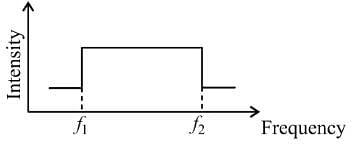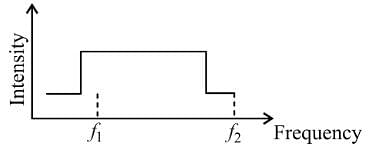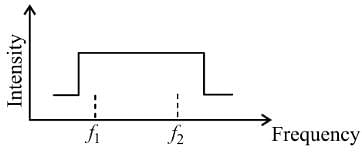JEE Exam > JEE Questions > Two trains A and B are moving with speeds 20 ...
Start Learning for Free
Two trains A and B are moving with speeds 20 m/s and 30 m/s respectively in the same direction on the same straight track, with B ahead of A. The engines are at the front ends. The engine of trains A blows a long whistle.

Assume that the sound of the whistle is composed of components varying in frequency from f1 = 800 Hz to f2 = 1120 Hz, as shown in the figure. The spread in the frequency (highest frequency - lowest frequency) is thus 320 Hz. The speed of sound in still air is 340 m/s.
The distribution of the sound intensity of the whistle as observed by the passengers in train A is best represented by

Assume that the sound of the whistle is composed of components varying in frequency from f1 = 800 Hz to f2 = 1120 Hz, as shown in the figure. The spread in the frequency (highest frequency - lowest frequency) is thus 320 Hz. The speed of sound in still air is 340 m/s.
The distribution of the sound intensity of the whistle as observed by the passengers in train A is best represented by
- a)

- b)

- c)

- d)

Correct answer is option 'A'. Can you explain this answer?
| FREE This question is part of | Download PDF Attempt this Test |
Most Upvoted Answer
Two trains A and B are moving with speeds 20 m/s and 30 m/s respective...
The engine as well as the passengers in train A are moving with the same velocity, therefore the distribution of sound intensity in the whistle remains unchanged.
Attention JEE Students!
To make sure you are not studying endlessly, EduRev has designed JEE study material, with Structured Courses, Videos, & Test Series. Plus get personalized analysis, doubt solving and improvement plans to achieve a great score in JEE.

|
Explore Courses for JEE exam
|

|
Similar JEE Doubts
Two trains A and B are moving with speeds 20 m/s and 30 m/s respectively in the same direction on the same straight track, with B ahead of A. The engines are at the front ends. The engine of trains A blows a long whistle.Assume that the sound of the whistle is composed of components varying in frequency from f1 = 800 Hz to f2= 1120 Hz, as shown in the figure. The spread in the frequency (highest frequency - lowest frequency) is thus 320 Hz. The speed of sound in still air is 340 m/s.The distribution of the sound intensity of the whistle as observed by the passengers in train A is best represented bya)b)c)d)Correct answer is option 'A'. Can you explain this answer?
Question Description
Two trains A and B are moving with speeds 20 m/s and 30 m/s respectively in the same direction on the same straight track, with B ahead of A. The engines are at the front ends. The engine of trains A blows a long whistle.Assume that the sound of the whistle is composed of components varying in frequency from f1 = 800 Hz to f2= 1120 Hz, as shown in the figure. The spread in the frequency (highest frequency - lowest frequency) is thus 320 Hz. The speed of sound in still air is 340 m/s.The distribution of the sound intensity of the whistle as observed by the passengers in train A is best represented bya)b)c)d)Correct answer is option 'A'. Can you explain this answer? for JEE 2024 is part of JEE preparation. The Question and answers have been prepared according to the JEE exam syllabus. Information about Two trains A and B are moving with speeds 20 m/s and 30 m/s respectively in the same direction on the same straight track, with B ahead of A. The engines are at the front ends. The engine of trains A blows a long whistle.Assume that the sound of the whistle is composed of components varying in frequency from f1 = 800 Hz to f2= 1120 Hz, as shown in the figure. The spread in the frequency (highest frequency - lowest frequency) is thus 320 Hz. The speed of sound in still air is 340 m/s.The distribution of the sound intensity of the whistle as observed by the passengers in train A is best represented bya)b)c)d)Correct answer is option 'A'. Can you explain this answer? covers all topics & solutions for JEE 2024 Exam. Find important definitions, questions, meanings, examples, exercises and tests below for Two trains A and B are moving with speeds 20 m/s and 30 m/s respectively in the same direction on the same straight track, with B ahead of A. The engines are at the front ends. The engine of trains A blows a long whistle.Assume that the sound of the whistle is composed of components varying in frequency from f1 = 800 Hz to f2= 1120 Hz, as shown in the figure. The spread in the frequency (highest frequency - lowest frequency) is thus 320 Hz. The speed of sound in still air is 340 m/s.The distribution of the sound intensity of the whistle as observed by the passengers in train A is best represented bya)b)c)d)Correct answer is option 'A'. Can you explain this answer?.
Two trains A and B are moving with speeds 20 m/s and 30 m/s respectively in the same direction on the same straight track, with B ahead of A. The engines are at the front ends. The engine of trains A blows a long whistle.Assume that the sound of the whistle is composed of components varying in frequency from f1 = 800 Hz to f2= 1120 Hz, as shown in the figure. The spread in the frequency (highest frequency - lowest frequency) is thus 320 Hz. The speed of sound in still air is 340 m/s.The distribution of the sound intensity of the whistle as observed by the passengers in train A is best represented bya)b)c)d)Correct answer is option 'A'. Can you explain this answer? for JEE 2024 is part of JEE preparation. The Question and answers have been prepared according to the JEE exam syllabus. Information about Two trains A and B are moving with speeds 20 m/s and 30 m/s respectively in the same direction on the same straight track, with B ahead of A. The engines are at the front ends. The engine of trains A blows a long whistle.Assume that the sound of the whistle is composed of components varying in frequency from f1 = 800 Hz to f2= 1120 Hz, as shown in the figure. The spread in the frequency (highest frequency - lowest frequency) is thus 320 Hz. The speed of sound in still air is 340 m/s.The distribution of the sound intensity of the whistle as observed by the passengers in train A is best represented bya)b)c)d)Correct answer is option 'A'. Can you explain this answer? covers all topics & solutions for JEE 2024 Exam. Find important definitions, questions, meanings, examples, exercises and tests below for Two trains A and B are moving with speeds 20 m/s and 30 m/s respectively in the same direction on the same straight track, with B ahead of A. The engines are at the front ends. The engine of trains A blows a long whistle.Assume that the sound of the whistle is composed of components varying in frequency from f1 = 800 Hz to f2= 1120 Hz, as shown in the figure. The spread in the frequency (highest frequency - lowest frequency) is thus 320 Hz. The speed of sound in still air is 340 m/s.The distribution of the sound intensity of the whistle as observed by the passengers in train A is best represented bya)b)c)d)Correct answer is option 'A'. Can you explain this answer?.
Solutions for Two trains A and B are moving with speeds 20 m/s and 30 m/s respectively in the same direction on the same straight track, with B ahead of A. The engines are at the front ends. The engine of trains A blows a long whistle.Assume that the sound of the whistle is composed of components varying in frequency from f1 = 800 Hz to f2= 1120 Hz, as shown in the figure. The spread in the frequency (highest frequency - lowest frequency) is thus 320 Hz. The speed of sound in still air is 340 m/s.The distribution of the sound intensity of the whistle as observed by the passengers in train A is best represented bya)b)c)d)Correct answer is option 'A'. Can you explain this answer? in English & in Hindi are available as part of our courses for JEE.
Download more important topics, notes, lectures and mock test series for JEE Exam by signing up for free.
Here you can find the meaning of Two trains A and B are moving with speeds 20 m/s and 30 m/s respectively in the same direction on the same straight track, with B ahead of A. The engines are at the front ends. The engine of trains A blows a long whistle.Assume that the sound of the whistle is composed of components varying in frequency from f1 = 800 Hz to f2= 1120 Hz, as shown in the figure. The spread in the frequency (highest frequency - lowest frequency) is thus 320 Hz. The speed of sound in still air is 340 m/s.The distribution of the sound intensity of the whistle as observed by the passengers in train A is best represented bya)b)c)d)Correct answer is option 'A'. Can you explain this answer? defined & explained in the simplest way possible. Besides giving the explanation of
Two trains A and B are moving with speeds 20 m/s and 30 m/s respectively in the same direction on the same straight track, with B ahead of A. The engines are at the front ends. The engine of trains A blows a long whistle.Assume that the sound of the whistle is composed of components varying in frequency from f1 = 800 Hz to f2= 1120 Hz, as shown in the figure. The spread in the frequency (highest frequency - lowest frequency) is thus 320 Hz. The speed of sound in still air is 340 m/s.The distribution of the sound intensity of the whistle as observed by the passengers in train A is best represented bya)b)c)d)Correct answer is option 'A'. Can you explain this answer?, a detailed solution for Two trains A and B are moving with speeds 20 m/s and 30 m/s respectively in the same direction on the same straight track, with B ahead of A. The engines are at the front ends. The engine of trains A blows a long whistle.Assume that the sound of the whistle is composed of components varying in frequency from f1 = 800 Hz to f2= 1120 Hz, as shown in the figure. The spread in the frequency (highest frequency - lowest frequency) is thus 320 Hz. The speed of sound in still air is 340 m/s.The distribution of the sound intensity of the whistle as observed by the passengers in train A is best represented bya)b)c)d)Correct answer is option 'A'. Can you explain this answer? has been provided alongside types of Two trains A and B are moving with speeds 20 m/s and 30 m/s respectively in the same direction on the same straight track, with B ahead of A. The engines are at the front ends. The engine of trains A blows a long whistle.Assume that the sound of the whistle is composed of components varying in frequency from f1 = 800 Hz to f2= 1120 Hz, as shown in the figure. The spread in the frequency (highest frequency - lowest frequency) is thus 320 Hz. The speed of sound in still air is 340 m/s.The distribution of the sound intensity of the whistle as observed by the passengers in train A is best represented bya)b)c)d)Correct answer is option 'A'. Can you explain this answer? theory, EduRev gives you an
ample number of questions to practice Two trains A and B are moving with speeds 20 m/s and 30 m/s respectively in the same direction on the same straight track, with B ahead of A. The engines are at the front ends. The engine of trains A blows a long whistle.Assume that the sound of the whistle is composed of components varying in frequency from f1 = 800 Hz to f2= 1120 Hz, as shown in the figure. The spread in the frequency (highest frequency - lowest frequency) is thus 320 Hz. The speed of sound in still air is 340 m/s.The distribution of the sound intensity of the whistle as observed by the passengers in train A is best represented bya)b)c)d)Correct answer is option 'A'. Can you explain this answer? tests, examples and also practice JEE tests.

|
Explore Courses for JEE exam
|

|
Suggested Free Tests
Signup for Free!
Signup to see your scores go up within 7 days! Learn & Practice with 1000+ FREE Notes, Videos & Tests.
























